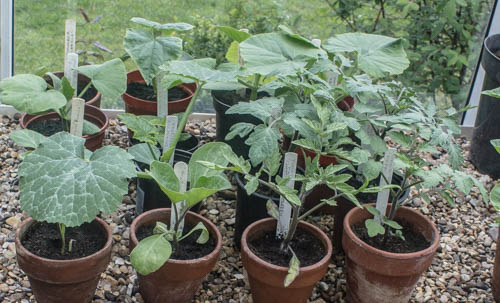
Sow: outdoor cucumber, marrow, squashes, pumpkins on edge, individually in 7.5cm pots plus French and Runner beans and Sweetcorn in gentle heat in multipurpose compost in a propagator.
Tie in the leading shoots of tomatoes, peppers and aubergines as they grow to support growing stems.
Continue to prick out and pot on seedlings, gradually increasing the pot by a single size each time until they reach the final pot size.
Damp down the floor of the greenhouse regularly on hot days. Increased humidity benefits plant growth and reduces pests like glasshouse red spider mite.
Paint your glasshouse with shading or close the blinds on sunny days to stop plants from overheating.
Increase the space between greenhouse plants as they grow to prevent disease, and manage early pest infestations. Check plants regularly for pests and diseases; they are easier to control when populations are small.
‘Harden off’ your half-hardy bedding plants and vegetable plants before transplanting. Put them straight out into the garden and they suffer from shock, most recover but it checks growth and causes sensitive crops to run to seed; ‘Morning Glory’ turns yellow ‘Hardening off’ takes two to three weeks, depending on the plant, the temperatures at which it grew while under cover and the garden’s location. Hardy plants acclimatise more rapidly than half-hardy or tender plants.
Transfer plants from heated to cooler conditions on a cloudy day, if possible or cover them with newspaper or fleece initially to prevent them from scorching or wilting. Plants raised in a heated glasshouse or on windowsills should be moved into a cold glasshouse for two weeks, then a well-ventilated cold frame for a final week. If you do not have a glasshouse, move plants into a cold frame. Open it a little during the day and close it at night, increasing ventilation gradually over time and remove the cover a few days before planting. Cover cold frames with carpet or hessian if late frost is forecast. If you don’t have a cold frame, place plants at the base of a sheltered, south facing wall or hedge, or somewhere sheltered during the day, protected for the first few days a couple of layers of fleece. Bring plants indoors at night, in the first week, and use a single layer of fleece for the first part of week two. After about 10 days, depending on the weather, remove the fleece during the day and leave plants outdoors at night if it’s mild. Leave them uncovered towards the end of the third week, before finally planting out. Timing is critical: tender plants should not be planted out until after the last frost in your area. Listen to weather forecasts and have cloches, fleece or newspaper, ready should late frosts occur. Tender plants can be damaged if hardened off’ below 12C(54F), Petunia, lobelia, Tagetes need temperatures around 10-12C (50-54F), tender bedding like pelargoniums and Bizzy Lizzie, can be planted when minimum night and day temperatures are 10C (50F) and 14-16C (57-61F) respectively.
Happy Gardening, Matt










